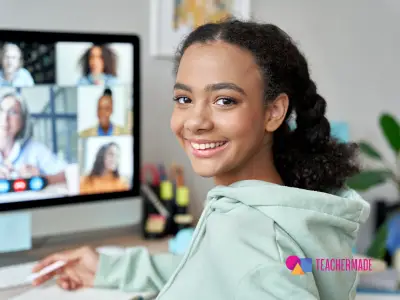Are you looking for the Classworks Special Education program from TouchMath? Click here to go to their site.
Are you looking for the Classworks Special Education program from TouchMath? Click here to go to their site.
You can use AI to create I Do, We Do, You Do strategies in the classroom. We’ll walk you through the gradual release strategy and how you can use ChatGPT to streamline your lesson planning.

The “I do, we do, you do” teaching strategy is an instructional approach commonly used in education to scaffold learning and gradually shift the responsibility of learning from the teacher to the student. The structured method helps students acquire new skills and concepts by providing guided practice and support before transitioning to independent practice. This strategy is often employed in various subjects and disciplines to help learners build confidence and competence. It’s one of the most effective teaching practices teachers use.
The “I do, we do, you do” strategy aligns with the principles of gradual release of responsibility, where the teacher gradually shifts from being the primary source of guidance to a facilitator, ultimately allowing students to take ownership of their learning. This approach is designed to support learners at different stages of development and help them build a solid foundation of understanding before engaging in independent practice.
The “I do, we do, you do” strategy is a specific implementation of the gradual release of responsibility framework.
It’s hard to teach something new and even harder to learn something new. That’s the biggest benefit of I Do, We Do, You Do – it gives everyone a framework to lean on. You will notice the benefits of gradual release immediately:
Here’s how each phase of the strategy works. Most teachers naturally gravitate towards gradual release, and you will find you’re already doing these things in the classroom without knowing its technical name.
In this phase, the teacher or instructor demonstrates the skill or concept, explaining each step and thought process aloud. This provides a clear model for students to follow and helps them understand the correct approach.
While you’re demonstrating, you are modeling your thinking. You may have to model beyond your typical thought process. For example, you may be a verbal learner and need to include a visual. It’s not about showing how you do it but rather how anyone can do it.
In this phase, the teacher and students work together collaboratively. The teacher guides the students through examples, exercises, or problems, with the students actively participating in the learning process. The teacher provides support, offers feedback, and addresses any questions or challenges.
This is typically where scaffolding occurs. You must know where your students are starting from, break tasks into smaller steps, and anticipate difficulties. It can be challenging to do this if you’re not gauging progress along the way with formative assessment. So be sure to build in tasks to measure learning progress.
In this final phase, students work independently to apply the skills or concepts they’ve learned. They practice on their own, applying the knowledge and techniques they acquired during the previous phases. The teacher may still be available for assistance if needed, but the emphasis is on student autonomy and mastery.
When students are on their own, they can really evaluate if they understand the concept. As you monitor learning, you can return to the “We Do” or even “I Do” levels if you determine students are not yet ready for independent practice.
One of the biggest hurdles to I Do, We Do, You Do is it relies on the teacher to generate seemingly endless practice exercises. There are some learning tasks where this is possible (i.e., changing the numbers in a long division question). But it can take a lot of work to come up with variety in many areas. You recognize a great question, but it’s hard to replicate.
You can use AI tools like ChatGPT to help. Because ChatGPT can replicate language, it can replicate the language in your preferred questions. So it’s perfect if you have the right question but need help reproducing it or modifying it. You can use ChatGPT to create varieties of the same questions. Here are some options and modifiers you can add to your request:
Once you have a formative assessment in place for I Do, We Do, You Do, you can use TeacherMade as a platform to deliver instant feedback and collect student data.
TeacherMade makes it easy for you to load assignments into our platform, digitize them, and give them to your students. TeacherMade provides teachers with the flexibility to: